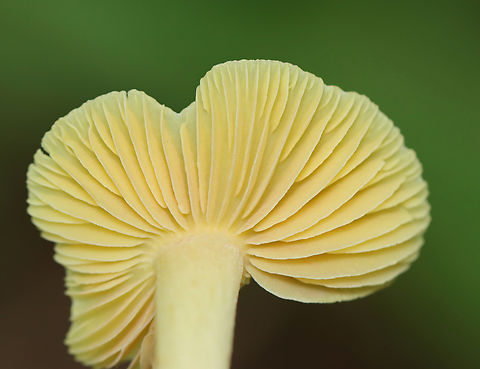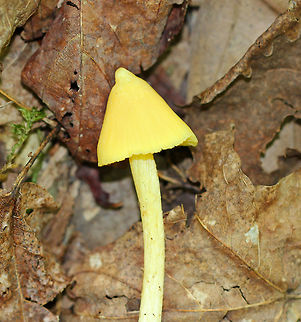
Appearance
The cap of "E. murrayi" is bell-shaped to conical, and measures 1.3–3 cm in diameter. It features a sharp umbo in the center. The cap color is bright yellow to orange-yellow, but tends to fade in maturity. The gills have a narrowly adnate attachment to the stem, and are well-spaced. Initially yellow, they acquire a pinkish tone as the spores mature.The slender hollow stem is 4–7.5 cm long and roughly equal in width throughout its length. It is pale yellow, with a fibrous surface, and often twisted with longitudinal striations. Its surface is smooth, and there may be a whitish mycelium at the base. The flesh is thin and pale yellow. The taste and odor of the fruit bodies have been described as either "pleasant", or indistinct. The mushroom is not edible and may be poisonous.
The spore print is salmon-pink. Spores are smooth, angular, hyaline, and measure 9–12 by 8–10 μm. The arrangement of the hyphae in the hymenophore tissue is parallel to interwoven and inamyloid. In the cap cuticle, the hyphae are interwoven radially, or alternatively in somewhat erect bundles. Hyphae of "Entoloma murrayi" rarely have clamp connections. The cap and gill tissue contain "repository hyphae" that release a watery, yellow-colored liquid when injured. These distinctive hyphae can be seen with light microscopy of both fresh and dried specimens.

Distribution
A saprobic species, "Entoloma murrayi" derives nutrients by breaking down organic matter. Fruit bodies are found in wet coniferous and deciduous forests, where they grow singly or in small groups on the ground in litterfall or humus, or in moss. Fruiting occurs in the summer and autumn.In North America, the species is found eastern Canada, the eastern United States, and Mexico. The distribution includes Central and South America, and Southeast Asia. It has also been recorded from Jamaica and the Dominican Republic.
References:
Some text fragments are auto parsed from Wikipedia.
